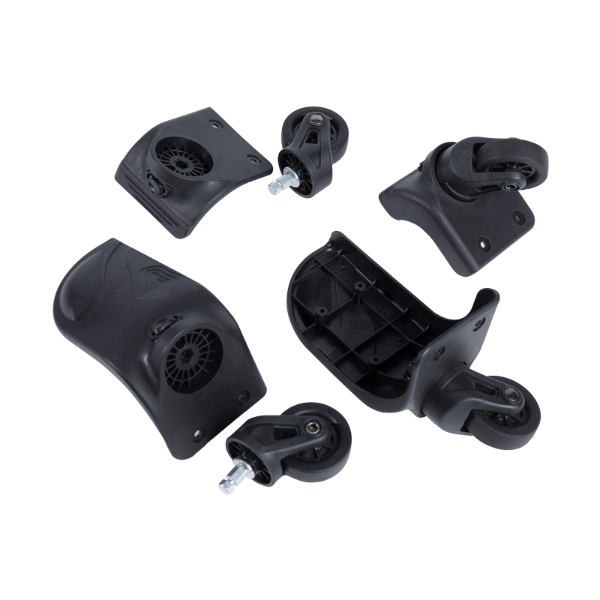From short weekend getaways to international adventures, luggage is an essential companion for every traveler. But among the many design elements that make a suitcase practical, luggage wheels might just be the most underrated. Without them, travelers would still be lugging heavy suitcases by hand, straining backs and shoulders. Today, luggage wheels have not only transformed how we carry our belongings—they’ve redefined the very experience of travel.
So how did this small yet impactful invention become a global travel necessity, and what should you know before choosing your next set of suitcase wheels?
1. The Evolution of Luggage Wheels
From Carry to Roll
Before the 1970s, all suitcases were carried by hand. In 1970, Bernard Sadow, an American luggage company executive, patented the first suitcase with wheels—essentially a standard case with four wheels and a strap for pulling.
Over time, designs evolved:
TwoWheel Uprights (1980s) – Easier to pull but still required tilting.
Spinner Wheels (2000s) – Four or more wheels that rotate 360°, allowing the suitcase to glide in any direction.
Hybrid & Smart Wheels (Today) – Combining multiple wheel types and adding features like shock absorption, quiet bearings, and even motorized assistance.
2. Types of Luggage Wheels
a) Inline Skate Wheels
Position: Usually recessed into the case.
Pros: Durable, stable on uneven surfaces, less exposed to damage.
Cons: Can only roll forward or backward (not sideways).
b) Spinner Wheels
Position: Mounted externally, usually four or eight total.
Pros: 360° maneuverability, easy to navigate in tight spaces like airplane aisles.
Cons: More exposed, may be less durable on rough terrain.
c) Removable Wheels
Pros: Easy to replace when damaged, reduces storage space.
Cons: Less common, may require specific replacements.
d) Powered Wheels
Pros: Some premium luggage now includes batterypowered wheels for effortless movement.
Cons: Heavy, expensive, and may face airline restrictions.

3. Materials Used in Luggage Wheels
Rubber – Quiet and smooth rolling, absorbs shock well.
Polyurethane (PU) – Durable, weatherresistant, commonly used in highquality spinner wheels.
Plastic – Lightweight but less durable, often found in budget luggage.
Metal Bearings – Stainless steel or chrome bearings improve smoothness and wheel lifespan.
4. Advantages of Wheeled Luggage
Effortless Transportation – Reduces strain on the body.
Faster Travel Through Airports – Glide through terminals without stopping to readjust heavy bags.
Better Organization – Allows for larger, heavier cases without sacrificing mobility.
Accessibility – Ideal for people who cannot carry heavy weights.
5. TwoWheel vs. FourWheel: Which Is Better?
| Feature | Two-Wheel Luggage | Four-Wheel Luggage (Spinners) |
| Maneuverability | Limited to forward/back tilt | Moves in all directions |
| Stability on Uneven Ground | Better on rough surfaces | Less stable on cobblestones |
| Storage Space | Wheels recessed, saves space | Wheels stick out, need more space |
| Durability | Less prone to damage | More exposed to wear |
6. Wheel Size and Placement
Larger wheels handle bumps, curbs, and cobblestones better, while smaller wheels work well on smooth airport floors. Recessed wheels are more protected, whereas protruding wheels allow for better mobility but risk breakage.
7. Maintenance and Care Tips
To extend the life of luggage wheels:
1. Clean Regularly – Remove dirt, hair, and debris from wheel axles.
2. Lubricate Bearings – Use silicone spray for smoother rolling.
3. Avoid Overloading – Excessive weight puts pressure on the wheel axles.
4. Replace When Needed – Many wheels can be replaced with simple tools.
8. Common Wheel Problems and Fixes
Wobbling Wheels – Usually due to loose screws or worn bearings.
Squeaky Wheels – A drop of lubricant can solve the noise.
Cracked Wheels – Replacement is better than repair, as cracks spread quickly.
Jammed Wheels – Remove debris and check for bent axles.
9. Choosing the Right Wheels for Your Travel Style
For Frequent Flyers – Highquality spinner wheels with PU material for smooth airport navigation.
For Rough Terrain Travelers – Twowheel inline skates with large rubber wheels for stability.
For Luxury Travel – Shockabsorbing wheels with quiet bearings for silent hotel hallways.
10. Innovations in Luggage Wheels
The luggage industry continues to innovate:
Suspension Systems – Reduce vibrations and protect belongings.
SelfAligning Wheels – Adjust automatically for better balance.
Smart Luggage – Electricpowered wheels and tracking systems.
EcoFriendly Materials – Recycled rubber and biodegradable plastics.
11. Sustainability Considerations
Choosing replaceable wheels instead of discarding an entire suitcase is both costeffective and ecofriendly. Some brands now offer lifetime wheel warranties, encouraging repair over replacement.
12. The Psychological Side of Rolling Luggage
It might sound funny, but luggage wheels have changed how we feel about travel. Rolling your suitcase effortlessly through a terminal feels less like “hauling baggage” and more like “gliding to your destination.” This subtle shift reduces stress and keeps energy focused on the trip itself.
Conclusion
While they may seem like a small part of a suitcase, luggage wheels are a gamechanging invention that has revolutionized the travel industry. From the first clunky fourwheeled models to today’s sleek, highperformance spinners, wheels have transformed suitcases into mobile, effortless companions.
The next time you pack for a trip, take a moment to appreciate the engineering behind those smoothrolling wheels—they’re not just carrying your luggage; they’re carrying your travel experience. And with innovations on the horizon, the future of luggage mobility looks even smoother.




 Español
Español











